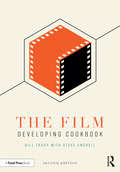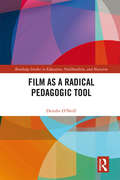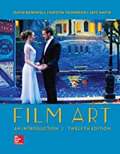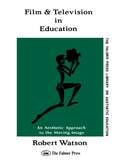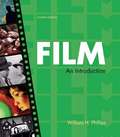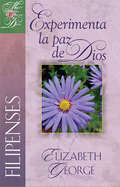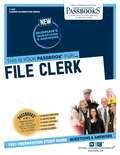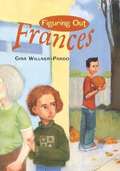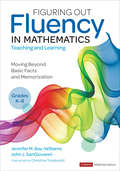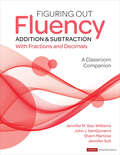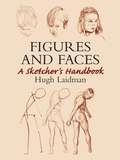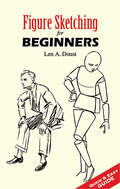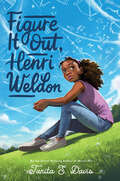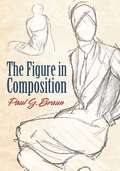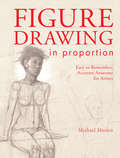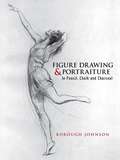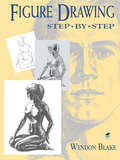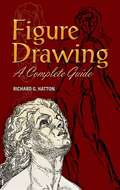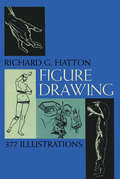- Table View
- List View
The Film Developing Cookbook
by Steve Anchell Bill TroopThe Film Developing Cookbook, 2nd edition is an up-to-date manual for photographic film development techniques. This book concentrates on films, their characteristics, and the developers each requires for maximum control of the resulting image. For two decades The Film Developing Cookbook has helped photographers acquire a working knowledge of photographic chemistry—what photo chemicals do and why—for black and white film developing. Now reissued in a revised and fully updated edition, this must-have manual for photographic film development techniques covers films, their characteristics, and the developers each require for maximum control of the resulting image. Readers will learn how to mix and use photographic solutions from scratch, and even how to create new ones. Includes invaluable information about films, developer ingredients, formulas, speed increasing, mixing and storing stock solutions, stop baths, fixers, washing, and chemical safety. A must-have for analog photography enthusiasts and any photography students using the darkroom. For in-depth discussion and questions on all things film or darkroom join the Darkroom Cookbook Forum, www.darkroomcookbook.com
Film as a Radical Pedagogic Tool (Routledge Studies in Education, Neoliberalism, and Marxism #15)
by Deirdre O'NeillEmerging from Inside Film, a project that helps prisoners and people on probation make their own films, this book discusses the need for working class people to represent themselves and challenge mainstream stereotypes and assumptions about them. This project gave prisoners and parolees the technical skills necessary to make their own films and tell their own stories in order to counter the ways they have been misrepresented. The author demonstrates that film and television are key means by which socioeconomically marginalized groups are classified according to hegemonic norms, as well as the ways such groups can undermine these misrepresentations through their use of the media. As a theoretical reflection on the Inside Film project and the relationship between filmmaking and education, this book explores what radical pedagogy looks like in action.
Film Art: An Introduction
by David Bordwell Kristin Thompson Jeff SmithFilm is an art form with a language and an aesthetic all its own. Since 1979, David Bordwell, Kristin Thompson and now, Co-Author, Jeff Smith's Film Art has been the best-selling and most widely respected introduction to the analysis of cinema. Taking a skills-centered approach supported by examples from many periods and countries, the authors help students develop a core set of analytical skills that will enrich their understanding of any film, in any genre. In-depth examples deepen students' appreciation for how creative choices by filmmakers affect what viewers experience and how they respond. Film Art is generously illustrated with more than 1,000 frame enlargements taken directly from completed films, providing concrete illustrations of key concepts. Along with updated examples and expanded coverage of digital filmmaking, the twelfth edition of Film Art delivers SmartBook, first and only adaptive reading experience currently available, designed to help students stay focused, maximize study time and retain basic concepts.
Film And Television In Education: An Aesthetic Approach To The Moving Image
by Robert WatsonFirst published in 1990. Routledge is an imprint of Taylor & Francis, an informa company.
Film: An Introduction
by William H. PhillipsFilm: An Introduction covers the movies students know and the films their instructors want them to know -- including the silent classics of D. W. Griffith and Sergei Eisenstein, the Hong Kong cinema of John Woo, the documentaries of Errol Morris and Michael Moore, and the contemporary films of Quentin Tarantino and Peter Jackson. Through meticulous coverage, an unmatched art program with over 500 frame enlargements, accessible language, and unique study tools, Film helps beginning students develop the critical skills they need to analyze films and understand the medium in all its variety.
Filipenses: Experimenta la paz de Dios
by Elizabeth GeorgeVivimos paralizados cuando no sabemos cómo reconciliarnos con nuestro pasado. Algunos creen que "el pasado no importa" y procuran reprimir el dolor una vez tras otra. Otros no logran renovarse y cambiar porque creen que el pasado es más importante que su
File Clerk: Passbooks Study Guide (Career Examination Series #C-254)
by National Learning CorporationThe File Clerk Passbook® prepares you for your test by allowing you to take practice exams in the subjects you need to study. It provides hundreds of questions and answers in the areas that will likely be covered on your upcoming exam, including but not limited to: Filing Practices, Indexing, Sorting and Cross-Referencing; Equipment and Terminology; Organizing Data into Tables and Records; Understanding and Interpreting Written Material; and more.
Figuring Out Frances
by Gina Willner-PardoWith a light touch, this insightful novel charts a fourth grader's course through the complexities of family and friendship. Abby is trying hard to understand the things that puzzle her. One is her friendship with Travis Mooney, who seems to be turning into just another obnoxious boy. Another is a mystery: Why does Grandma, who has Alzheimer's disease, sometimes call her Frances? Who is, or was, Frances? Abby is convinced that if she can figure out Frances, she will know something new and important about herself. Along with the surprising and satisfying solution to this mystery comes the discovery that some things can't be figured out but just as in doing a puzzle, putting all the pieces together is the fun part.
Figuring Out Fluency in Mathematics Teaching and Learning, Grades K-8: Moving Beyond Basic Facts and Memorization (Corwin Mathematics Series)
by John J. SanGiovanni Jennifer M. Bay-WilliamsBecause fluency practice is not a worksheet. Fluency in mathematics is more than adeptly using basic facts or implementing algorithms. Real fluency involves reasoning and creativity, and it varies by the situation at hand. Figuring Out Fluency in Mathematics Teaching and Learning offers educators the inspiration to develop a deeper understanding of procedural fluency, along with a plethora of pragmatic tools for shifting classrooms toward a fluency approach. In a friendly and accessible style, this hands-on guide empowers educators to support students in acquiring the repertoire of reasoning strategies necessary to becoming versatile and nimble mathematical thinkers. It includes: "Seven Significant Strategies" to teach to students as they work toward procedural fluency. Activities, fluency routines, and games that encourage learning the efficiency, flexibility, and accuracy essential to real fluency. Reflection questions, connections to mathematical standards, and techniques for assessing all components of fluency. Suggestions for engaging families in understanding and supporting fluency. Fluency is more than a toolbox of strategies to choose from; it’s also a matter of equity and access for all learners. Give your students the knowledge and power to become confident mathematical thinkers.
Figuring Out Fluency in Mathematics Teaching and Learning, Grades K-8: Moving Beyond Basic Facts and Memorization (Corwin Mathematics Series)
by John J. SanGiovanni Jennifer M. Bay-WilliamsBecause fluency practice is not a worksheet. Fluency in mathematics is more than adeptly using basic facts or implementing algorithms. Real fluency involves reasoning and creativity, and it varies by the situation at hand. Figuring Out Fluency in Mathematics Teaching and Learning offers educators the inspiration to develop a deeper understanding of procedural fluency, along with a plethora of pragmatic tools for shifting classrooms toward a fluency approach. In a friendly and accessible style, this hands-on guide empowers educators to support students in acquiring the repertoire of reasoning strategies necessary to becoming versatile and nimble mathematical thinkers. It includes: "Seven Significant Strategies" to teach to students as they work toward procedural fluency. Activities, fluency routines, and games that encourage learning the efficiency, flexibility, and accuracy essential to real fluency. Reflection questions, connections to mathematical standards, and techniques for assessing all components of fluency. Suggestions for engaging families in understanding and supporting fluency. Fluency is more than a toolbox of strategies to choose from; it’s also a matter of equity and access for all learners. Give your students the knowledge and power to become confident mathematical thinkers.
Figuring Out Fluency - Addition and Subtraction With Fractions and Decimals: A Classroom Companion (Corwin Mathematics Series)
by Jennifer M. Bay-Williams John J. SanGiovanni Sherri L. Martinie Jennifer SuhBecause fluency practice is not a worksheet. Fluency in mathematics is more than adeptly using basic facts or implementing algorithms. It is not about speed or recall. Real fluency is about choosing strategies that are efficient, flexible, lead to accurate solutions, and are appropriate for the given situation. Developing fluency is also a matter of equity and access for all learners. The landmark book Figuring Out Fluency in Mathematics Teaching and Learning offered educators the inspiration to develop a deeper understanding of procedural fluency, along with a plethora of pragmatic tools for shifting classrooms toward a fluency approach. Now, teachers have the chance to apply that inspiration through explicit instruction and practice every day with the classroom companion Figuring Out Fluency: Addition and Subtraction with Fractions and Decimals. With this book, teachers can: Dive deeper into the Significant Strategies for fluency explained in the anchor book Learn how these strategies grow from and relate to the basic fact strategies children learn Access over 100 strategy-aligned and classroom-ready activities for fluency instruction and practice in adding and subtracting fractions and decimals, including worked examples, routines, games, and centers Find activities for assessing all components of addition and subtraction fluency for fractions and decimals, plus support for engaging families Download all of the needed support tools, game boards, and other resources from the companion website for immediate implementation. Give each and every student the knowledge and power to become skilled and confident mathematical thinkers and doers.
Figuring Out Fluency - Addition and Subtraction With Fractions and Decimals: A Classroom Companion (Corwin Mathematics Series)
by Jennifer M. Bay-Williams John J. SanGiovanni Sherri L. Martinie Jennifer SuhBecause fluency practice is not a worksheet. Fluency in mathematics is more than adeptly using basic facts or implementing algorithms. It is not about speed or recall. Real fluency is about choosing strategies that are efficient, flexible, lead to accurate solutions, and are appropriate for the given situation. Developing fluency is also a matter of equity and access for all learners. The landmark book Figuring Out Fluency in Mathematics Teaching and Learning offered educators the inspiration to develop a deeper understanding of procedural fluency, along with a plethora of pragmatic tools for shifting classrooms toward a fluency approach. Now, teachers have the chance to apply that inspiration through explicit instruction and practice every day with the classroom companion Figuring Out Fluency: Addition and Subtraction with Fractions and Decimals. With this book, teachers can: Dive deeper into the Significant Strategies for fluency explained in the anchor book Learn how these strategies grow from and relate to the basic fact strategies children learn Access over 100 strategy-aligned and classroom-ready activities for fluency instruction and practice in adding and subtracting fractions and decimals, including worked examples, routines, games, and centers Find activities for assessing all components of addition and subtraction fluency for fractions and decimals, plus support for engaging families Download all of the needed support tools, game boards, and other resources from the companion website for immediate implementation. Give each and every student the knowledge and power to become skilled and confident mathematical thinkers and doers.
Figures, Faces & Folds: Women's Form and Dress for Artists, Students and Designers
by Adolphe Armand BraunRanging from classical to contemporary eras, this art instruction manual presents a historical overview of the depiction of women in drawings, paintings, sculpture, and photography. The highly detailed study is generously illustrated with black-and-white photographs, line drawings, and reproductions of paintings by Botticelli, Rubens, Vermeer, and other masters. More than 100 reference photos, referred to as "The Standard Poses," offer an additional resource for figure study. Suitable for intermediate to advanced students of art, the two-part treatment examines modes of dress and their appearance in art, followed by the reference photos. Topics range from drapery studies and the structure of dress to the anatomy of the body and the skeleton. Contemporary poses portray all aspects and positions of the body in action as well as repose and include a section on hands and gloves.
Figures and Faces: A Sketcher's Handbook (Dover Art Instruction)
by Hugh LaidmanArtist, illustrator, and teacher Hugh Laidman shows how simple and rewarding it can be to draw two of the most challenging of artistic subjects -- the male and female figures.A brief review of anatomical structure is followed by detailed illustrations and clear instructions for rendering line, tone, structure, and form in a variety of techniques. Explanatory drawings, practice exercises, and step-by-step photographs are used to discuss sketching, sustained and contour drawing, working with charcoal or pastels, as well as finding and posing models and drawing people of different ages and ethnic groups. Art students to professionals will find the text's direct terminology and detailed illustrations of immense value.
Figure Sketching for Beginners
by Len A. DoustIf a drawing "is not alive, it is a failure," declares Len A. Doust. With his practical help and encouraging guidance, even novice sketchers can learn how to capture the vitality and character of their models.Clear instructions and 23 step-by-step illustrations highlight everything students need to know. Featured topics include:* Perspective and proportions* Heads, faces, and hands* Hats, shoes, and clothing* Age and character* Expressions* Athletes and dancersConcise and informative, this manual offers sketchers the perfect way to get started.
Figure Sculpture in Wax and Plaster
by Richard MillerStep-by-step guide to materials and tools, modeling in wax and plaster, hollow wax modeling, plaster molds, and much more. Introduction. "The beginning artist will find the step-by-step instructions...to be like having a personal tutor." -- Enchantment. 281 photographs.
Figure It Out, Henri Weldon
by Tanita S. DavisTanita S. Davis, author of Partly Cloudy and Serena Says, has written another funny, warm story featuring middle school and family life—all about the complex calculations it takes for everyone to balance the equations of their lives and what it takes to be part of a team while handling a learning disability. This middle grade novel is perfect for fans of From the Desk of Zoe Washington and A Good Kind of Trouble.Seventh grader Henrietta Weldon gets to switch schools—finally! She’ll be “mainstreaming” into public school, leaving her special education school behind. She can’t wait for her new schedule, new friends, and new classes.Henri’s dyscalculia, a learning disability that makes math challenging to process and understand, is what she expects to give her problems. What she doesn’t expect is a family feud with her sister over her new friends, joining the girls’ soccer team, and discovering poetry. Henri’s tutor and new friend, Vinnie, reminds her to take it slow. One problem at a time.If Henri Weldon has twenty-four hours in a day, and she has two siblings who dislike her four new friends, two hours of soccer practice, seven hours of classes, and three hours of homework . . . she has:A. No free timeB. No idea how to make everyone happyC. No time to figure it out, Henri Weldon!
The Figure in Composition (Dover Art Instruction Ser.)
by Paul G. BraunStudents and professionals alike will benefit from this focus on the figure in the overall composition of a sketch or drawing. Its solid instruction and many fine examples make it a particularly valuable tool for intermediate artists.Author Paul G. Braun examines the concept of arrangement with single and multiple figures and within a border. Additional topics include the distribution of light and shade, draped figures and folds, the depiction of movement, and many other aspects of figure drawing. The final chapter offers pointers on how to illustrate a story, and numerous helpful sketches complement this guide's teachings.
Figure Drawing Master Class: Lessons in Life Drawing
by Dan GhenoWith Figure Drawing Master Class, you will discover the secrets to creating masterful figure drawings through examples of Old Master drawings, as well as Dan Gheno's own beautiful drawings, demonstrations and diagrams.This take-home course covers everything you need to put yourself on the fast-track to successful figure drawing.Inside you'll find:The basics of training your hand to drawGesture drawing lessonsHow to draw heads and handsHow to accurately compose your figuresKeys to replicating the subtle details in the posture of the head to suggest emotionThe basics of human proportionsWith tips, tricks and historical references, the drawing instruction inside will help you with all the critical skills you need to travel your own journey through successful figure drawing and improve your drawings for years to come.Learn to draw all aspects of the human figure with diagrams, demonstrations and Old Master drawingsMore than 120 drawings by Old Master artists including Michelangelo, Leonardo, Raphael and RembrandtIncludes 5 step-by-step demonstrations to reinforce the key concepts of figure drawing
Figure Drawing in Proportion: Easy to Remember, Accurate Anatomy for Artists
by Michael MassenAn intuitive approach for figure artists to get proportions right. Traditional methods of measuring body proportions rely on the abstract memorization of convoluted fractions or multiples of the human head. But artists shouldn't have to be mathematicians. Figure Drawing in Proportion introduces a better, more intuitive, less intimidating way to get proportions right. It starts with the revelation that--despite the wonderful variety of bodies in this world--the human figure has standard size relationships artists can build upon for accurate renderings. If you know, for example, that the collarbone is the same width as the head, it's much easier to draw the head in proper relationship to the shoulders. Knowing that the palm should be the same width as the knee helps establish the correct relationships in a seated portrait. This book highlights dozens of such key internal and comparative measurements. Once you start looking, you will discover even more. Ideal for any level of artist, this practical approach to proportions makes figure drawing more approachable and more rewarding. Inside you'll find:9 full step-by-step demonstrations, using various poses and figures to show proportioning techniques in practice.Internal and comparative measurements and how to apply them to figure drawings.Simple strategies for recalling key proportions as you work.
Figure Drawing and Portraiture: In Pencil, Chalk and Charcoal
by Borough JohnsonFrom an award-winning English artist and teacher whose work was exhibited at the esteemed Paris Salon and London's Royal Academy comes a beautifully designed guide to drawing the face and figure. The author of such artistic references as "The Technique of Pencil Drawing" and "The Art of the Pencil," Borough Johnson also illustrated many famous poems and novels, including Longfellow's "Evangeline" and Hardy's Tess of the D'Urbervilles."Art cannot be taught. Drawing, like science, can." With those opening words, Borough Johnson takes a creative step forward, demonstrating how to draw the human figure with shading and texture, using pencil, chalk, and charcoal. In easy-to-follow terms, he explores the most important aspects of drawing the human form: anatomy, proportion, composition, motion, drawing from memory, and capturing emotion with an economy of line. He also offers eighty-two of his own compositions in black-and-white--subjects that include a ballerina, fencer, gypsies, violinist, children playing, and more--to illustrate his lessons. Eight color plates (red chalk drawings) are also included. Perfect for intermediate and advanced students who want to improve their skills, Figure Drawing and Portraiture is a valuable guide for every artist's reference shelf.
Figure Drawing: Step by Step
by Wendon BlakeSince ancient times the nude figure has been painted, sculpted, and drawn by countless artists. Today, art instructors still maintain that drawing the nude is the best way to perfect drawing skills, This abundantly illustrated guide provides students with all the information they need to portray the human figure skillfully.Noted artist and art teacher Wendon Blake begins by showing students how to establish proportions; he then provides helpful suggestions for drawing torsos, heads, arms and hands, legs and feet. This is followed by detailed instructions for depicting ten complete figures. Step-by-step demonstrations show you how to draw simple subjects such as standing and seated figures, as well as figures in more complex poses (bending, kneeling, twisting, and crouching). Students will also learn how to establish major forms, refine lines for increased accuracy, block in broad shadow areas, and finish the work by polishing contours, strengthening shadows, and adding details. Some 170 illustrations covering a variety of pencil, chalk, and charcoal techniques not only present every drawing operation in precise detail but also reveal how to develop form, light, and shade by combining lines, strokes, and blended tones. Beginners will appreciate this volume's clear instructions, practical advice, and detailed illustrations, while more experienced artists will find it an excellent review of the basics and a source of valuable insights.
Figure Drawing: A Complete Guide
by Richard G. HattonOne of the few available guidebooks of its kind, this manual approaches figure drawing from the draftsman's point of view. With a clear focus on surface lines and prominences, step-by-step instructions and over 300 illustrations guide artists in accurately sketching all aspects of the human form in lively action and repose.Beginning with method and proportion, the author discusses the drawing of lines, contours, planes, masses, and rounded forms. Moving on to the individual parts of the body, simple principles of anatomy are applied to demonstrate techniques for sketching the head and neck, the trunk, the upper and lower limbs, and the digits. Expertly rendered figures are shown in various positions and movements, and from all angles, for the most thorough, concise instruction. Brimming with the basic elements necessary for creating quality works of art, Figure Drawing also includes guidance for drawing drapery, revealing the main points of support on the body and the proper way to sketch the folds and forms of garments. Immensely practical and highly readable, it is a manual that artists of every level will turn to again and again.
Figure Drawing: A Complete Guide (Dover Anatomy for Artists)
by Richard G. HattonWhile there are any number of anatomy texts and handbooks for artists, this is one of the few available studies that approach the art of figure drawing from the point of view of the draftsman. Though it does provide a fund of information on all important anatomical features and functions, the book stresses how the figure-sketcher should handle his subject, how he should actually put down surface lines and prominences on paper. It is an immensely practical guide for the student. The text covers all aspects of drawing the human form. An important introductory section deals with methods of drawing and the proper proportioning of the body. Then the author treats the various parts of the body in full detail: head and neck (over 100 pages on facial features, etc.), the trunk (chest, abdomen, vertebral column, breast, pelvis, shoulders, etc.) and the upper and lower limbs and digits. A final discussion takes up the topic of drapery, the main points of support on the body, and various styles of representing the folds and forms of garments. Three hundred seventy-seven figures, mostly sketches by the author, but including some examples from classical times and famous artists, illustrate the text. These figures show undraped men and women of all ages and types in various positions and movements and from all angles (full front view, profile, three-quarter view, rear view, etc.) so that the coverage is as thorough as possible for the student. Other drawings show and identify muscles and elements of the skeletal system and indicate their relation to surface contours. A clear and readable account with many helpful suggestions on sketching technique, the book offers a nontechnical, inexpensive home-study course or supplementary text for the beginning artist. Those art students who derive little or no benefit from anatomy courses would do well to study this volume. Unabridged, unaltered republication of original edition.
